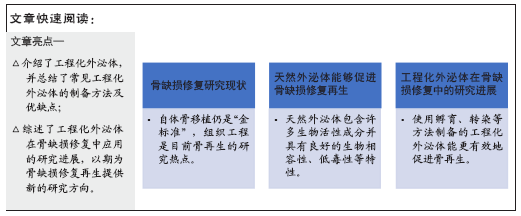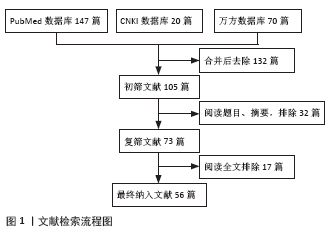[1] 韩志琪,蒋伟东,周诺.干细胞组织工程技术辅助下颌牵张成骨的研究与进展[J].中国组织工程研究,2019,23(25):4037-4043.
[2] VELASCO MA, NARVÁEZ-TOVAR CA, GARZÓN-ALVARADO DA. Design, materials, and mechanobiology of biodegradable scaffolds for bone tissue engineering. Biomed Res Int. 2015;2015:729076.
[3] 王良,李军,沈毅,等.虚拟手术辅助的血管化腓骨肌(皮)瓣行下颌骨精确重建[J].中国耳鼻咽喉颅底外科杂志,2016,22(3):220-224.
[4] 张赛,张龙城.下颌骨缺损修复的研究进展[J].中国耳鼻咽喉颅底外科杂志,2017,23(2):177-181.
[5] RUSTOM LE, BOUDOU T, NEMKE BW, et al. Multiscale Porosity Directs Bone Regeneration in Biphasic Calcium Phosphate Scaffolds. ACS Biomater Sci Eng. 2017;3(11):2768-2778.
[6] BABAIE E, BHADURI SB. Fabrication Aspects of Porous Biomaterials in Orthopedic Applications: A Review. ACS Biomater Sci Eng. 2017;4(1):1-39.
[7] GARCÍA-GARETA E, HUA J, ORERA A, et al. Biomimetic surface functionalization of clinically relevant metals used as orthopaedic and dental implants. Biomed Mater. 2017;13(1):015008.
[8] ROSETI L, PARISI V, PETRETTA M, et al. Scaffolds for Bone Tissue Engineering: State of the art and new perspectives. Mater Sci Eng C Mater Biol Appl. 2017;78:1246-1262.
[9] EL-BADAWY A, AHMED SM, EL-BADRI N. Adipose-Derived Stem Cell-Based Therapies in Regenerative Medicine. Advances in Stem Cell Therapy. 2017;10:117-138.
[10] GUAY C, KRUIT JK, ROME S, et al. Lymphocyte-Derived Exosomal MicroRNAs Promote Pancreatic β Cell Death and May Contribute to Type 1 Diabetes Development. Cell Metab. 2019;29(2):348-361.
[11] CHEUNG KL, JARRETT R, SUBRAMANIAM S, et al. Psoriatic T cells recognize neolipid antigens generated by mast cell phospholipase delivered by exosomes and presented by CD1a. J Exp Med. 2016; 213(11):2399-2412.
[12] BOURDONNAY E, ZASŁONA Z, PENKE LR, et al. Transcellular delivery of vesicular SOCS proteins from macrophages to epithelial cells blunts inflammatory signaling. J Exp Med. 2015;212(5):729-742.
[13] 贺娇,许泼实.外泌体提取方法及鉴定分析研究进展[J].中华实用诊断与治疗杂志,2018,32(7):718-721.
[14] 宋赛赛,贺娇,程琳.外泌体的研究进展[J].智慧健康,2019,5(22): 57-59.
[15] RODRIGUES M, FAN J, LYON C, et al. Role of Extracellular Vesicles in Viral and Bacterial Infections: Pathogenesis, Diagnostics, and Therapeutics. Theranostics. 2018;8(10):2709-2721.
[16] SKOTLAND T, HESSVIK NP, SANDVIG K, et al. Exosomal lipid composition and the role of ether lipids and phosphoinositides in exosome biology. J Lipid Res. 2019;60(1):9-18.
[17] SCHILLER LT, LEMUS-DIAZ N, RINALDI FERREIRA R, et al. Enhanced Production of Exosome-Associated AAV by Overexpression of the Tetraspanin CD9. Mol Ther Methods Clin Dev. 2018;9:278-287.
[18] KALLURI R. The biology and function of exosomes in cancer. J Clin Invest. 2016;126(4):1208-1215.
[19] VAN NIEL G, D’ANGELO G, RAPOSO G. Shedding light on the cell biology of extracellular vesicles. Nat Rev Mol Cell Biol. 2018;19(4):213-228.
[20] WIKLANDER OPB, BRENNAN MÁ, LÖTVALL J, et al. Advances in therapeutic applications of extracellular vesicles. Sci Transl Med. 2019; 11(492):eaav8521.
[21] XIN H, KATAKOWSKI M, WANG F, et al. MicroRNA cluster miR-17-92 Cluster in Exosomes Enhance Neuroplasticity and Functional Recovery After Stroke in Rats. Stroke. 2017;48(3):747-753.
[22] VADER P, MOL EA, PASTERKAMP G, et al. Extracellular vesicles for drug delivery. Adv Drug Deliv Rev. 2016;106(Pt A):148-156.
[23] KOOIJMANS SAA, SCHIFFELERS RM, ZAROVNI N, et al. Modulation of tissue tropism and biological activity of exosomes and other extracellular vesicles: New nanotools for cancer treatment. Pharmacol Res. 2016;111:487-500.
[24] ARMSTRONG JPK, STEVENS MM. Strategic design of extracellular vesicle drug delivery systems. Adv Drug Deliv Rev. 2018;130:12-16.
[25] KIBRIA G, RAMOS EK, WAN Y, et al. Exosomes as a Drug Delivery System in Cancer Therapy: Potential and Challenges. Mol Pharm. 2018;15(9): 3625-3633.
[26] LÄSSER C, JANG SC, LÖTVALL J. Subpopulations of extracellular vesicles and their therapeutic potential. Mol Aspects Med. 2018;60:1-14.
[27] QI X, ZHANG J, YUAN H, et al. Exosomes Secreted by Human-Induced Pluripotent Stem Cell-Derived Mesenchymal Stem Cells Repair Critical-Sized Bone Defects through Enhanced Angiogenesis and Osteogenesis in Osteoporotic Rats. Int J Biol Sci. 2016;12(7):836-849.
[28] ZHANG J, LIU X, LI H, et al. Exosomes/tricalcium phosphate combination scaffolds can enhance bone regeneration by activating the PI3K/Akt signaling pathway. Stem Cell Res Ther. 2016;7(1):136.
[29] 张静,易阳艳,阳水发,等.脂肪干细胞来源外泌体对人脐静脉血管内皮细胞增殖、迁移及管样分化的影响[J].中国修复重建外科杂志,2018,32(10):1351-1357.
[30] 柳鑫,肖燕,江川,等.牙髓干细胞来源外泌体诱导内皮细胞血管生成能力的研究[J].牙体牙髓牙周病学杂志,2018,28(4):187-196.
[31] ARENACCIO C, CHIOZZINI C, FERRANTELLI F, et al. Exosomes in Therapy: Engineering, Pharmacokinetics and Future Applications. Curr Drug Targets. 2019;20(1):87-95.
[32] LIAO W, DU Y, ZHANG C, et al. Exosomes: The next generation of endogenous nanomaterials for advanced drug delivery and therapy. Acta Biomater. 2019;86:1-14.
[33] PASCUCCI L, COCCÈ V, BONOMI A, et al. Paclitaxel is incorporated by mesenchymal stromal cells and released in exosomes that inhibit in vitro tumor growth: a new approach for drug delivery. J Control Release. 2014;192:262-270.
[34] SATO YT, UMEZAKI K, SAWADA S, et al. ngineering hybrid exosomes by membrane fusion with liposomes. Sci Rep. 2016;6:21933.
[35] FUHRMANN G, SERIO A, MAZO M, et al. Active loading into extracellular vesicles significantly improves the cellular uptake and photodynamic effect of porphyrins. J Control Release. 2015;205:35-44.
[36] WAN Y, WANG L, ZHU C, et al. Aptamer-Conjugated Extracellular Nanovesicles for Targeted Drug Delivery. Cancer Res. 2018;78(3):798-808.
[37] KIM MS, HANEY MJ, ZHAO Y, et al. Development of exosome-encapsulated paclitaxel to overcome MDR in cancer cells. Nanomedicine. 2016;12(3):655-664.
[38] JOHNSEN KB, GUDBERGSSON JM, SKOV MN, et al. Evaluation of electroporation-induced adverse effects on adipose-derived stem cell exosomes. Cytotechnology. 2016;68(5):2125-2138.
[39] HOOD JL. Post isolation modification of exosomes for nanomedicine applications. Nanomedicine (Lond). 2016;11(13):1745-1756.
[40] TIAN T, ZHANG HX, HE CP, et al. Surface functionalized exosomes as targeted drug delivery vehicles for cerebral ischemia therapy. Biomaterials. 2018;150:137-149.
[41] ZHAO Z, MCGILL J, GAMERO-KUBOTA P, et al. Microfluidic on-demand engineering of exosomes towards cancer immunotherapy. Lab Chip. 2019;19(10):1877-1886.
[42] STICKNEY Z, LOSACCO J, MCDEVITT S, et al. Development of exosome surface display technology in living human cells. Biochem Biophys Res Commun. 2016;472(1):53-59.
[43] LUAN X, SANSANAPHONGPRICHA K, MYERS I, et al. Engineering exosomes as refined biological nanoplatforms for drug delivery. Acta Pharmacol Sin. 2017;38(6):754-763.
[44] LI H, LIU D, LI C, et al. Exosomes secreted from mutant-HIF-1α-modified bone-marrow-derived mesenchymal stem cells attenuate early steroid-induced avascular necrosis of femoral head in rabbit. Cell Biol Int. 2017; 41(12):1379-1390.
[45] SAKAGUCHI K, SAKAI K, SUGIMURA‐WAKAYAMA Y, et al. Bone regeneration using exosomes derived from hMSCs stimulated by hypoxia. Clin Oral Implants Res. 2019;30(s19):126.
[46] LIANG B, LIANG JM, DING JN, et al. Dimethyloxaloylglycine-stimulated human bone marrow mesenchymal stem cell-derived exosomes enhance bone regeneration through angiogenesis by targeting the AKT/mTOR pathway. Stem Cell Res Ther. 2019;10(1):335.
[47] LUO ZW, LI FX, LIU YW, et al. Aptamer-functionalized exosomes from bone marrow stromal cells target bone to promote bone regeneration. Nanoscale. 2019;11(43):20884-20892.
[48] 罗月,梁卓,吕永钢.过表达microRNA-764间充质干细胞来源外泌体促骨再生[J].医用生物力学,2019,34(s1):57.
[49] MA J, ZHAO Y, SUN L, et al. Exosomes Derived from Akt-Modified Human Umbilical Cord Mesenchymal Stem Cells Improve Cardiac Regeneration and Promote Angiogenesis via Activating Platelet-Derived Growth Factor D. Stem Cells Transl Med. 2017;6(1):51-59.
[50] INGATO D, LEE JU, SIM SJ, et al. Good things come in small packages: Overcoming challenges to harness extracellular vesicles for therapeutic delivery. J Control Release. 2016;241:174-185.
[51] ZHANG Y, CHOPP M, LIU XS, et al. Exosomes Derived from Mesenchymal Stromal Cells Promote Axonal Growth of Cortical Neurons. Mol Neurobiol. 2017;54(4):2659-2673.
[52] BOSCH S, DE BEAUREPAIRE L, ALLARD M, et al. Trehalose prevents aggregation of exosomes and cryodamage. Sci Rep. 2016;6:36162.
[53] CHAROENVIRIYAKUL C, TAKAHASHI Y, NISHIKAWA M, et al. Preservation of exosomes at room temperature using lyophilization. Int J Pharm. 2018;553(1-2):1-7.
[54] LI P, KASLAN M, LEE SH, et al. Progress in Exosome Isolation Techniques. Theranostics. 2017;7(3):789-804.
[55] SONG H, LI X, ZHAO Z, et al. Reversal of Osteoporotic Activity by Endothelial Cell-Secreted Bone Targeting and Biocompatible Exosomes. Nano Lett. 2019;19(5):3040-3048.
[56] LI S, WU Y, DING F, et al. Engineering macrophage-derived exosomes for targeted chemotherapy of triple-negative breast cancer. Nanoscale. 2020;12(19):10854-10862. |



